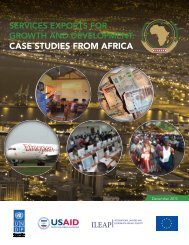BUDGET
budget
budget
You also want an ePaper? Increase the reach of your titles
YUMPU automatically turns print PDFs into web optimized ePapers that Google loves.
102 A GOVERNMENT OF THE FUTURE<br />
return on this investment through effective<br />
partnerships with academia, industry, and regional<br />
innovation networks. For example, the<br />
National Aeronautics and Space Administration<br />
has partnered with companies to make experimentation<br />
on the International Space Station<br />
more accessible to researchers, an approach that<br />
has played a significant role in jump-starting<br />
a new industry in very small satellites. In the<br />
case of the Department of Energy, industry partnerships<br />
can help broadly develop and deploy<br />
important next generation energy technologies<br />
and high-performance computers.<br />
The Budget reflects the Administration’s commitment<br />
to accelerating the transfer of the results<br />
of federally funded research to the commercial<br />
marketplace by prioritizing funding for Lab-to-<br />
Market programs at the National Institute of<br />
Standards and Technology ($8 million) and for<br />
NSF’s public-private Innovation Corps (I-Corps)<br />
program ($30 million). Both of these programs<br />
are developing tools and best practices that<br />
are invigorating efforts to commercialize the<br />
results of federally funded R&D. For example,<br />
the I-Corps program at NSF has 10 agreements<br />
with other Federal agencies that are using its<br />
experiential entrepreneurial curriculum to train<br />
research scientists, graduate students, and other<br />
entrepreneurs in how to identify and mature discoveries<br />
ripe for commercialization. In addition,<br />
I-Corps has a growing number of partnerships<br />
with non-Federal entities, such as with the State<br />
of Ohio. The Budget also provides $50 million<br />
in mandatory funding for a new competitive<br />
grant program, building on the success of prior<br />
Economic Development Administration-led<br />
activities, to incentivize partnerships between<br />
Federal labs, academia, and regional economic<br />
development organizations to enable the transfer<br />
of knowledge and technologies from labs to<br />
private industry for commercialization. In addition,<br />
the Department of Energy is making the<br />
technologies and tools developed by its national<br />
labs more available to small businesses and<br />
entrepreneurs through innovative approaches<br />
designed to unlock new business or productive<br />
opportunities.<br />
PEOPLE AND CULTURE: UNLOCKING THE FULL POTENTIAL<br />
OF TODAY’S FEDERAL WORKFORCE AND BUILDING THE<br />
WORKFORCE WE NEED FOR TOMORROW<br />
In his December 2014 address to Federal Senior<br />
Executives, President Obama said,“[W]e need<br />
the best and brightest of the coming generations<br />
to serve. [T]hose of us who believe government<br />
can and must be a force for good…we’ve got<br />
to work hard to make sure that government<br />
works.” Through the Management Agenda’s focus<br />
on People and Culture, the Administration<br />
is committed to undertaking executive actions to<br />
attract and retain the best talent for the Federal<br />
workforce and foster a culture of excellence. The<br />
Budget supports efforts to strengthen the Senior<br />
Executive Service (SES) and improve employee<br />
engagement in order to fully capitalize on the<br />
talents in today’s Federal workforce at all levels,<br />
and recruit and develop the talent needed to continue<br />
moving the Federal Government forward<br />
in the 21 st Century.<br />
White House Advisory Group<br />
The White House Advisory Group on Senior<br />
Executive Service Reform, comprised of 24 leaders<br />
from across the Federal Government, was<br />
announced in December 2014 and charged with<br />
making recommendations for improving the way<br />
the Federal Government recruits, hires, develops,<br />
retains, manages, and holds accountable,<br />
top senior career leaders. The final reforms focus<br />
on three key areas: 1) hiring the best talent; 2)<br />
strengthening SES development; and 3) improving<br />
SES accountability, recognition, and rewards.<br />
On December 15, 2015, the President signed<br />
an Executive Order titled “Strengthening the<br />
Senior Executive Service” that included reforms<br />
to improve the hiring and selection processes<br />
and increase rotations to broaden experience and<br />
succession planning. In addition, the President’s<br />
Management Council formed a subcommittee to




